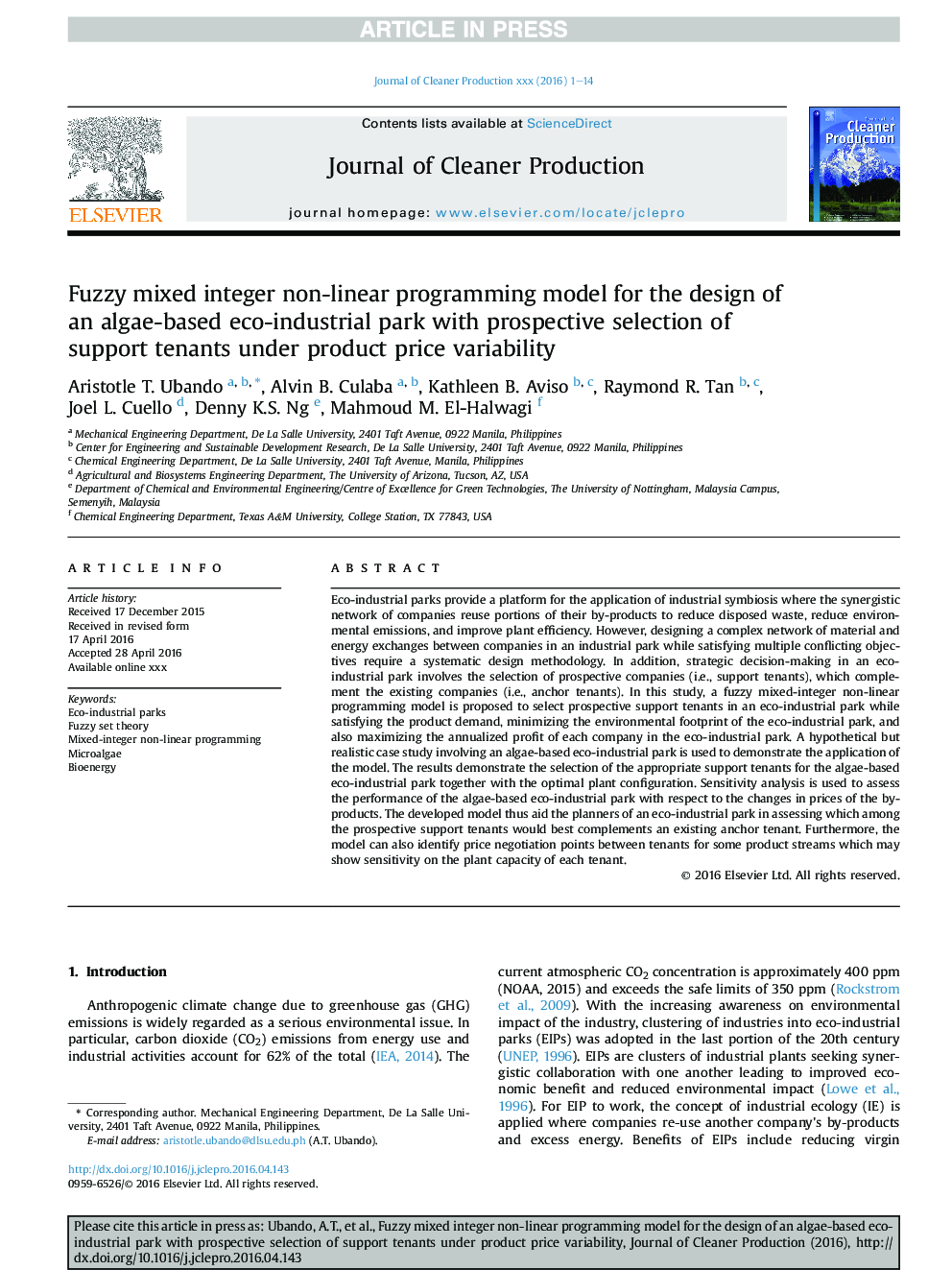| کد مقاله | کد نشریه | سال انتشار | مقاله انگلیسی | نسخه تمام متن |
|---|---|---|---|---|
| 5480620 | 1399319 | 2016 | 14 صفحه PDF | دانلود رایگان |
عنوان انگلیسی مقاله ISI
Fuzzy mixed integer non-linear programming model for the design of an algae-based eco-industrial park with prospective selection of support tenants under product price variability
ترجمه فارسی عنوان
مدل برنامه ریزی غیر خطی اعداد صحیح فازی برای طراحی پارک اکولوژیکی صنعتی مبتنی بر جلبک با انتخاب آینده ای از مستاجران پشتیبانی تحت تنوع قیمت محصول
دانلود مقاله + سفارش ترجمه
دانلود مقاله ISI انگلیسی
رایگان برای ایرانیان
کلمات کلیدی
ترجمه چکیده
پارک های صنعتی صنعتی زمینه ای برای استفاده از همزیستی صنعتی فراهم می کند که در آن شبکه های هم افزایی شرکت ها بخش هایی از محصولات جانبی خود را مجددا استفاده می کنند تا ضایعات دفن شده را کاهش دهند، باعث کاهش انتشار مواد زیست محیطی و بهبود کارایی کارخانه شوند. با این حال، طراحی یک شبکه پیچیده مبادلات مواد و انرژی بین شرکت ها در یک پارک صنعتی در حالی که رضایت چندین اهداف متضاد، نیاز به یک روش طراحی سیستماتیک است. علاوه بر این، تصمیم گیری استراتژیک در پارک صنعتی صنعتی شامل انتخاب شرکت های آینده (یعنی حمایت از مستاجران) است که شرکت های موجود (به عنوان مثال، مستاجران لنگر) را تکمیل می کند. در این مطالعه یک مدل برنامه ریزی غیر خطی تلفیقی فازی مخلوط، برای انتخاب حامیان آینده حمایتی در یک پارک صنعتی صنعتی، در حالی که رضایت تقاضای محصول، به حداقل رساندن اثرات زیست محیطی پارک اکولوژیکی صنعتی، و همچنین به حداکثر رساندن سود سالانه از هر شرکت در پارک صنعتی صنعتی. نمونه ای از مطالعات فرض، اما واقع بینانه که شامل پارک اکولوژیکی مبتنی بر جلبک است، برای نشان دادن کاربرد مدل استفاده می شود. نتایج نشان می دهد انتخاب مستاجران پشتیبانی مناسب برای پارک اکولوژیکی مبتنی بر جلبک همراه با پیکربندی بهینه گیاه. تجزیه و تحلیل حساسیت برای ارزیابی عملکرد پارک اکولوژیکی مبتنی بر جلبک با توجه به تغییرات قیمت محصولات کنار محصول مورد استفاده قرار می گیرد. بنابراین مدل توسعه یافته به برنامه ریزان یک پارک صنعتی صنعتی کمک می کند تا در ارزیابی این که کدام یک از مستاجران حمایت کننده آینده بهتر از مستاجر لنگر موجود خواهد بود. علاوه بر این، مدل همچنین می تواند نقاط مذاکره قیمت بین مستاجرین برای برخی از جریان های محصول را شناسایی کند که ممکن است حساسیت نسبت به ظرفیت کارخانه هر مستاجر را نشان دهد.
موضوعات مرتبط
مهندسی و علوم پایه
مهندسی انرژی
انرژی های تجدید پذیر، توسعه پایدار و محیط زیست
چکیده انگلیسی
Eco-industrial parks provide a platform for the application of industrial symbiosis where the synergistic network of companies reuse portions of their by-products to reduce disposed waste, reduce environmental emissions, and improve plant efficiency. However, designing a complex network of material and energy exchanges between companies in an industrial park while satisfying multiple conflicting objectives require a systematic design methodology. In addition, strategic decision-making in an eco-industrial park involves the selection of prospective companies (i.e., support tenants), which complement the existing companies (i.e., anchor tenants). In this study, a fuzzy mixed-integer non-linear programming model is proposed to select prospective support tenants in an eco-industrial park while satisfying the product demand, minimizing the environmental footprint of the eco-industrial park, and also maximizing the annualized profit of each company in the eco-industrial park. A hypothetical but realistic case study involving an algae-based eco-industrial park is used to demonstrate the application of the model. The results demonstrate the selection of the appropriate support tenants for the algae-based eco-industrial park together with the optimal plant configuration. Sensitivity analysis is used to assess the performance of the algae-based eco-industrial park with respect to the changes in prices of the by-products. The developed model thus aid the planners of an eco-industrial park in assessing which among the prospective support tenants would best complements an existing anchor tenant. Furthermore, the model can also identify price negotiation points between tenants for some product streams which may show sensitivity on the plant capacity of each tenant.
ناشر
Database: Elsevier - ScienceDirect (ساینس دایرکت)
Journal: Journal of Cleaner Production - Volume 136, Part B, 10 November 2016, Pages 183-196
Journal: Journal of Cleaner Production - Volume 136, Part B, 10 November 2016, Pages 183-196
نویسندگان
Aristotle T. Ubando, Alvin B. Culaba, Kathleen B. Aviso, Raymond R. Tan, Joel L. Cuello, Denny K.S. Ng, Mahmoud M. El-Halwagi,
